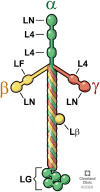Defective perlecan-associated basement membrane regeneration and altered modulation of transforming growth factor beta in corneal fibrosis
- PMID: 35188596
- PMCID: PMC8972081
- DOI: 10.1007/s00018-022-04184-7
Defective perlecan-associated basement membrane regeneration and altered modulation of transforming growth factor beta in corneal fibrosis
Abstract
In the cornea, the epithelial basement membrane (EBM) and corneal endothelial Descemet's basement membrane (DBM) critically regulate the localization, availability and, therefore, the functions of transforming growth factor (TGF)β1, TGFβ2, and platelet-derived growth factors (PDGF) that modulate myofibroblast development. Defective regeneration of the EBM, and notably diminished perlecan incorporation, occurs via several mechanisms and results in excessive and prolonged penetration of pro-fibrotic growth factors into the stroma. These growth factors drive mature myofibroblast development from both corneal fibroblasts and bone marrow-derived fibrocytes, and then the persistence of these myofibroblasts and the disordered collagens and other matrix materials they produce to generate stromal scarring fibrosis. Corneal stromal fibrosis often resolves completely if the inciting factor is removed and the BM regenerates. Similar defects in BM regeneration are likely associated with the development of fibrosis in other organs where perlecan has a critical role in the modulation of signaling by TGFβ1 and TGFβ2. Other BM components, such as collagen type IV and collagen type XIII, are also critical regulators of TGF beta (and other growth factors) in the cornea and other organs. After injury, BM components are dynamically secreted and assembled through the cooperation of neighboring cells-for example, the epithelial cells and keratocytes for the corneal EBM and corneal endothelial cells and keratocytes for the corneal DBM. One of the most critical functions of these reassembled BMs in all organs is to modulate the pro-fibrotic effects of TGFβs, PDGFs and other growth factors between tissues that comprise the organ.
Keywords: Basement membrane assembly; Collagen type IV; Cornea; Descemet’s membrane; Dystroglycan; Epithelial barrier function; Epithelial basement membrane; HGF; Integrins; KGF; Laminins; Nidogens; PDGF; Perlecan; Regeneration; TGF beta.
© 2022. The Author(s), under exclusive licence to Springer Nature Switzerland AG.
Conflict of interest statement
The author does not have any commercial or proprietary interests in the subject matter of this review article.
Figures







Similar articles
-
Corneal epithelial basement membrane: Structure, function and regeneration.Exp Eye Res. 2020 May;194:108002. doi: 10.1016/j.exer.2020.108002. Epub 2020 Mar 13. Exp Eye Res. 2020. PMID: 32179076 Free PMC article. Review.
-
The Corneal Basement Membranes and Stromal Fibrosis.Invest Ophthalmol Vis Sci. 2018 Aug 1;59(10):4044-4053. doi: 10.1167/iovs.18-24428. Invest Ophthalmol Vis Sci. 2018. PMID: 30098200 Free PMC article. Review.
-
TGFβ1 and TGFβ2 proteins in corneas with and without stromal fibrosis: Delayed regeneration of apical epithelial growth factor barrier and the epithelial basement membrane in corneas with stromal fibrosis.Exp Eye Res. 2021 Jan;202:108325. doi: 10.1016/j.exer.2020.108325. Epub 2020 Oct 22. Exp Eye Res. 2021. PMID: 33263285 Free PMC article.
-
Fibrosis Is a Basement Membrane-Related Disease in the Cornea: Injury and Defective Regeneration of Basement Membranes May Underlie Fibrosis in Other Organs.Cells. 2022 Jan 17;11(2):309. doi: 10.3390/cells11020309. Cells. 2022. PMID: 35053425 Free PMC article. Review.
-
Descemet's membrane injury and regeneration, and posterior corneal fibrosis, in rabbits.Exp Eye Res. 2021 Dec;213:108803. doi: 10.1016/j.exer.2021.108803. Epub 2021 Nov 2. Exp Eye Res. 2021. PMID: 34736886
Cited by
-
The impact of UV cross-linking on corneal stromal cell migration, differentiation and patterning.Exp Eye Res. 2023 Aug;233:109523. doi: 10.1016/j.exer.2023.109523. Epub 2023 Jun 2. Exp Eye Res. 2023. PMID: 37271309 Free PMC article.
-
Clearing the light path: proteoglycans and their important roles in the lens and cornea.Proteoglycan Res. 2024 Apr-Jun;2(2):e20. doi: 10.1002/pgr2.20. Epub 2024 May 8. Proteoglycan Res. 2024. PMID: 39568541 Free PMC article.
-
Role of matrix metalloproteinase in wound healing.Am J Transl Res. 2022 Jul 15;14(7):4391-4405. eCollection 2022. Am J Transl Res. 2022. PMID: 35958464 Free PMC article. Review.
-
Topical Losartan Decreases Myofibroblast Generation But Not Corneal Opacity After Surface Blast-Simulating Irregular PTK in Rabbits.Transl Vis Sci Technol. 2023 Sep 1;12(9):20. doi: 10.1167/tvst.12.9.20. Transl Vis Sci Technol. 2023. PMID: 37750746 Free PMC article.
-
The Yin and Yang of Mesenchymal Cells in the Corneal Stromal Fibrosis Response to Injury: The Cornea as a Model of Fibrosis in Other Organs.Biomolecules. 2022 Dec 31;13(1):87. doi: 10.3390/biom13010087. Biomolecules. 2022. PMID: 36671472 Free PMC article. Review.
References
-
- Yurchenco PD, O’Rear J. Supramolecular organization of basement membranes. In: Rohrbach DH, Timpl R, editors. Molecular and cellular aspects of basement membranes. San Diego: Academic Press; 1993. pp. 20–47.
-
- Martinez-Hernandez A, Amenta PS. The basement membrane in pathology. Lab Invest. 1983;48:656–677. - PubMed
Publication types
MeSH terms
Substances
Grants and funding
LinkOut - more resources
Full Text Sources
Medical

